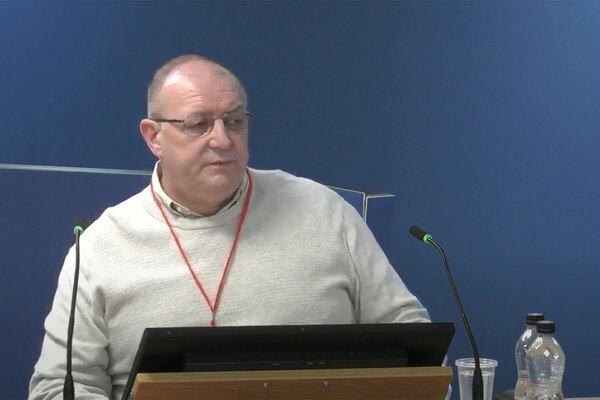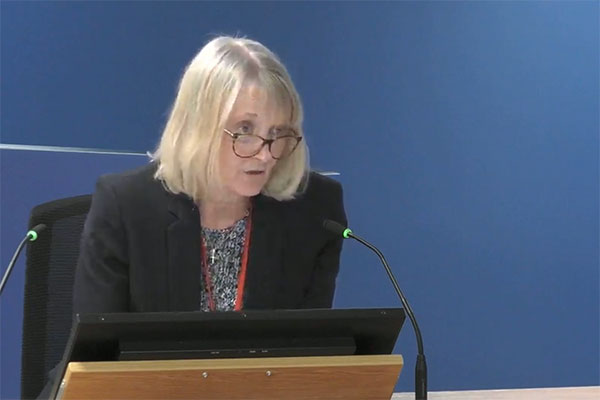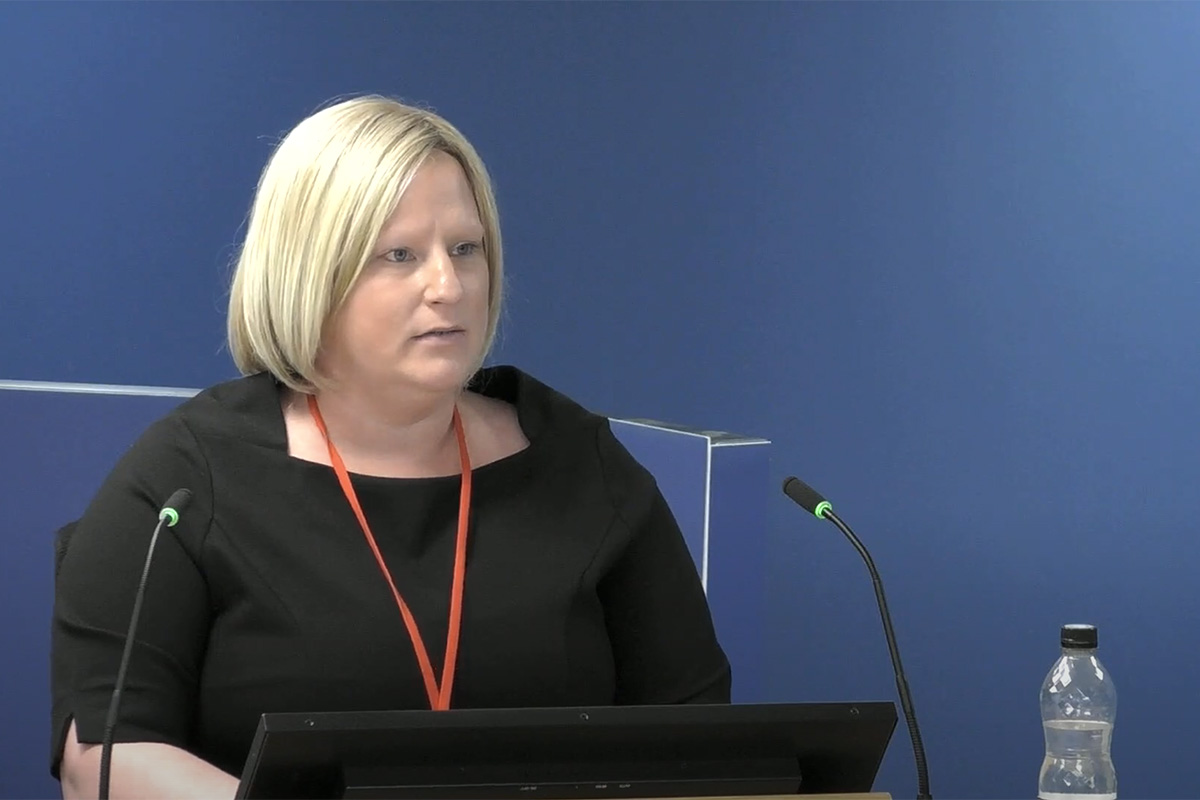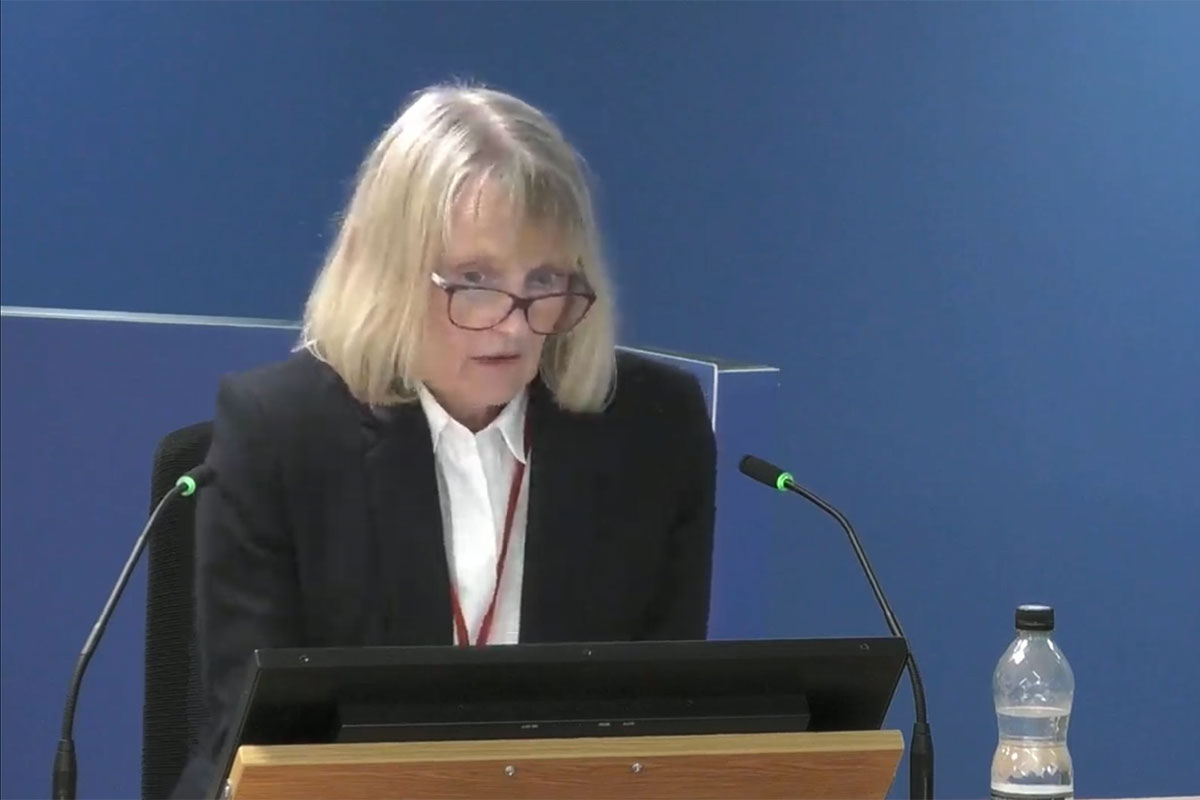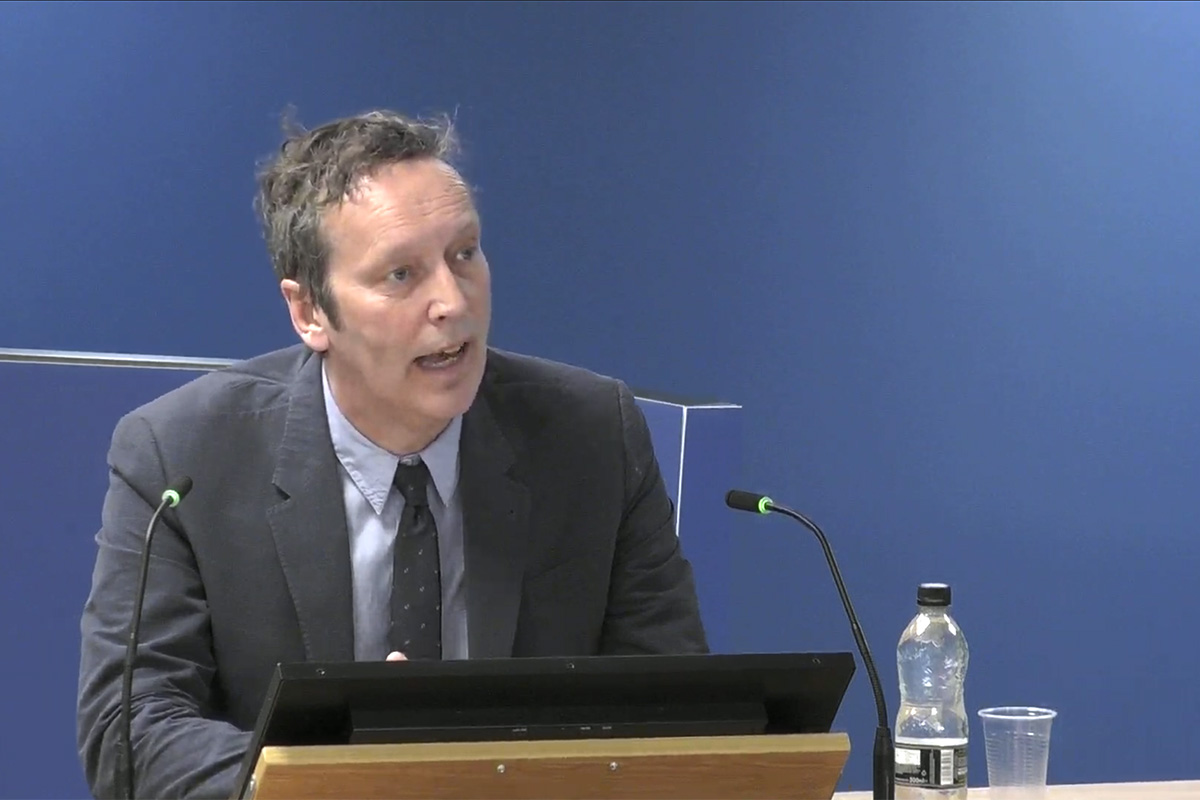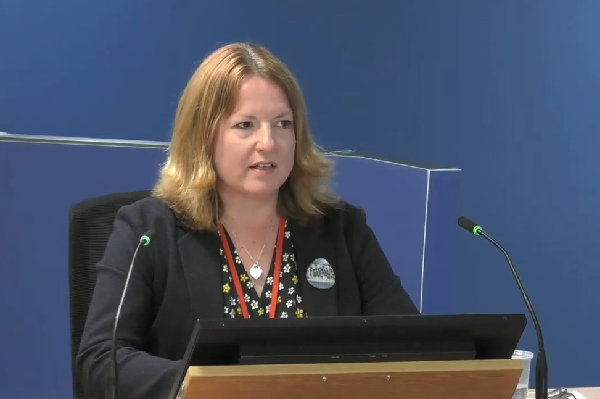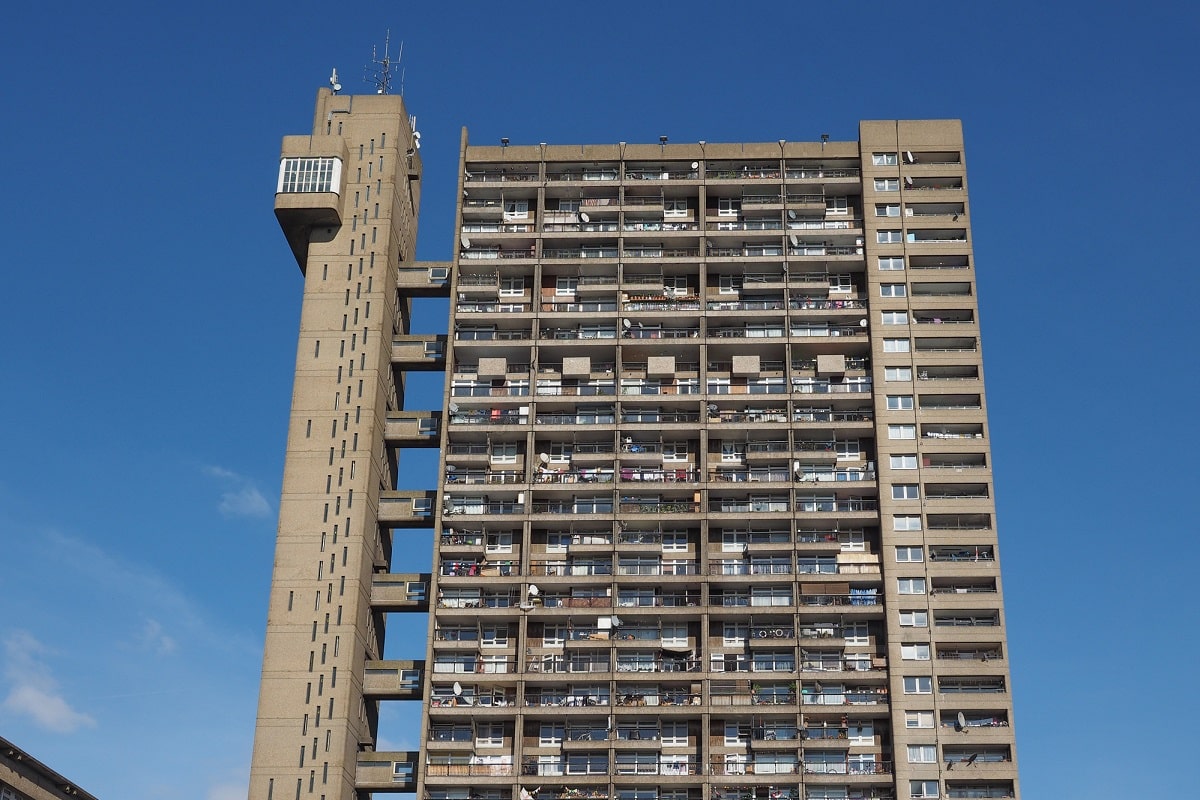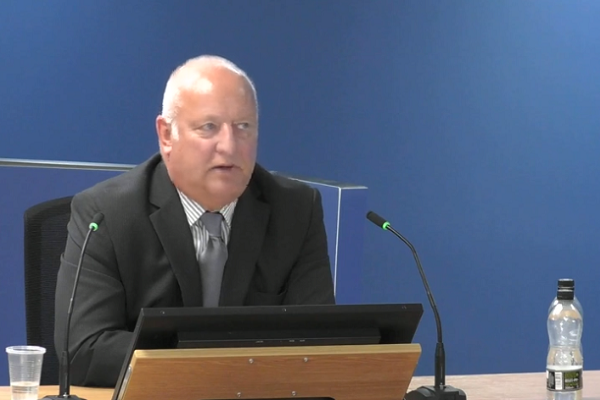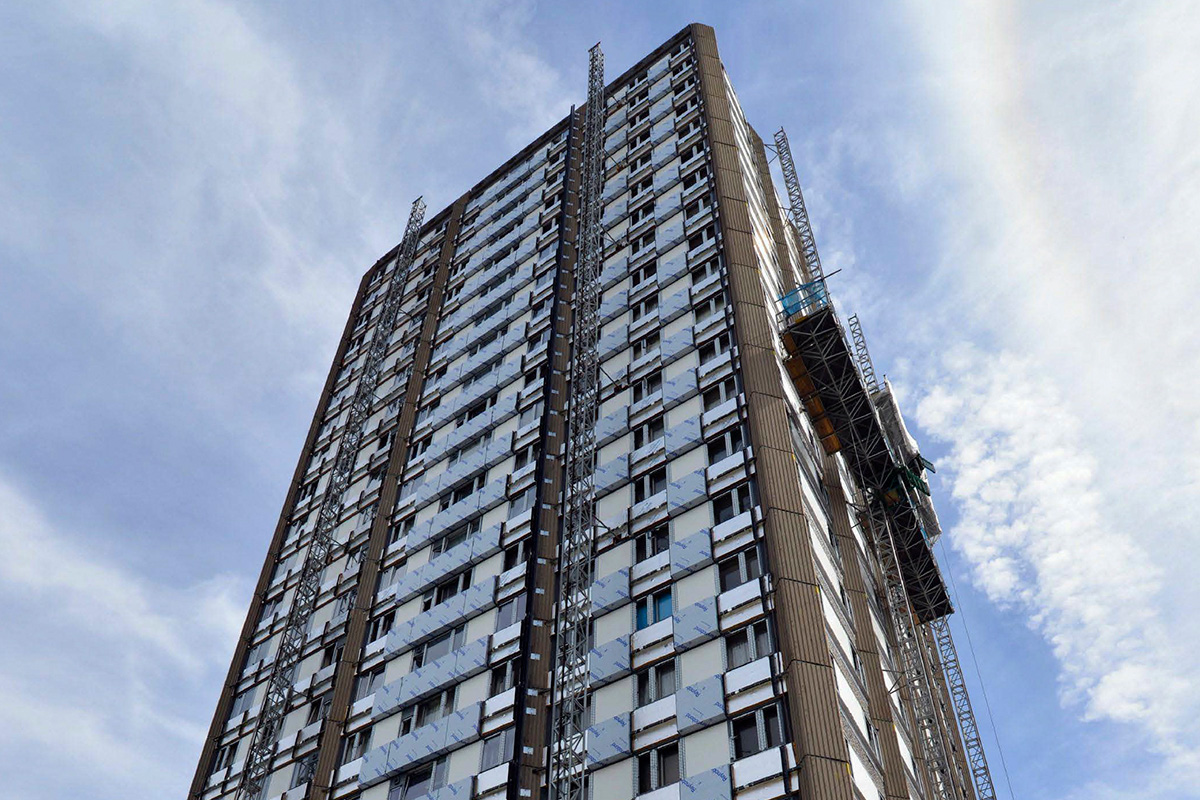Grenfell Tower Inquiry diary week 38: ‘Well it’s a bit more than that, isn’t it. He’s suggesting that you tell the LFB a lie’
The inquiry heard the mammoth cross-examination of KCTMO’s health and safety manager Janice Wray this week. Peter Apps reports
Janice Wray first started working at the Royal Borough of Kensington and Chelsea (RBKC) in 1986, and at Kensington and Chelsea Tenant Management Organisation (KCTMO) from its formation 1996 to its abolition in 2018 following the Grenfell Tower fire.
Her role was to advise on health and safety issues affecting the organisation. This included a wide range of issues, such as asbestos and accidents, but the important one for the inquiry is fire safety. What was Ms Wray responsible for? What advice did she give? Should she have done more to address some the failures that the inquiry has already uncovered?
These questions were the theme of her mammoth (and not yet complete) cross-examination across the past four days. We pick up some of the key areas investigated below.
‘Do you know why your report doesn’t comment on the urgent and critical concerns raised by Salvus?’
In 2005, legislative changes required social landlords to carry out fire risk assessments to their blocks for the first time.
Initially, KCTMO tried to carry this out in-house, using members of Ms Wray’s (pictured above) health and safety team to do their risk assessments, despite their lack of formal qualifications.
In 2009, the London Fire Brigade (LFB) took issue with this approach. At a meeting in August 2009, its representatives said told KCTMO “assessments so far had not been up to a satisfactory standard” and warned it would issue an enforcement notice if a professional was not appointed.
Consultancy Salvus was appointed in September 2009 and asked to carry out assessments to KCTMO’s 110 high-risk blocks within six months.
Three weeks after its appointment, Salvus produced a report on general fire safety management arrangements within KCTMO and its conclusions were damning.
The report identified 19 areas where Salvus believed KCTMO was in breach of its statutory obligations. It covered issues such as the lack of an overall fire safety policy for the organisation, emergency plans for its tower blocks and formal policies for disabled and vulnerable residents.
But when Ms Wray prepared a report for the organisation’s board in October 2009, she did not mention these failings, recording that Salvus believed the organisation to “have good fire safety policies and procedures in place” albeit not always “consistently documented”.
“Do you know why your report to the board here doesn’t comment on many of the urgent and critical concerns raised by Salvus in their management report?” asked counsel to the inquiry Richard Millett QC.
Ms Wray claimed she did not see the report until November and did not yet know of its its contents – despite having had a meeting with Salvus two days after it was written in September.
But a further report to the board in December 2009 still did not mention the failures, it simply said the report “sets out the fire safety framework within which we and our [contractors] should be working”.
“Can you account for why, on the face of it, this paragraph says absolutely nothing about any of the statutory breaches or any of the defects in fire safety management that Salvus had identified in that September management report?” asked Mr Millett.
“No, I can’t give you an explanation,” said Ms Wray.
‘I believe they have shown some reluctance to challenge the LFB on thorny issues’
Salvus’ appointment to work for KCTMO did not last long. Rather than reappoint the consultancy to carry out further risk assessments to its medium-risk blocks, Ms Wray and her colleagues elected to reprocure.
They ended up appointing Carl Stokes, a firefighter with 19 years’ experience who had been working for Salvus on the contract but applied to take it on as a sole trader. He would carry out KCTMO’s risk assessments for the next six-and-a-half years, from 2010 until the Grenfell Tower fire.
But why was Mr Stokes chosen?
In February 2010, Ms Wray wrote to staff at RBKC suggesting retendering for the medium-risk programme.
“I have some concerns that Salvus are very rule-bound and despite what they say about being prepared to challenge the LFB and acting on our behalf as we are their client, I believe they have shown some reluctance to challenge the LFB on thorny issues,” she wrote.
She said this email related to a specific issue with some blocks that had been built without dry risers (hollow pipes which can be charged with water from an external hydrant to fill firefighters hoses on upper floors).
She said Salvus had “sat on the fence” about whether these would need to be retrofitted, as the LFB had demanded, and she wanted someone willing to give a “clear steer”.
This answer was challenged by Mr Millett (pictured above). “You’re not really saying that they’re giving you muddy advice or they’re being equivocal; what you’re saying is they’re taking the LFB’s side as opposed to taking your side,” he said. “That’s how I read that. Is that an unfair reading, Ms Wray?”
“That might be what it says, but that wasn’t what I meant it to say, having lived it,” she replied. “My view was I just needed to be absolutely sure [about the advice being given].”
‘This issue is not helped by a breakdown in communication between the health and safety and other departments’
With Mr Stokes appointed, the programme of fire risk assessments was at least being carried out. But the problem – as has been covered repeatedly with other witnesses – is that KCTMO was not very good at carrying out the actions Mr Stokes identified as necessary.
In fact, by 2014 the organisation had an enormous backlog of 1,400 actions outstanding. It chipped away at this list over the next three years but never got it under control and had 287 actions still outstanding at the time of the Grenfell Tower fire.
What was Ms Wray’s explanation for the backlog? She described the process as “frustrating”.
“I was chasing people and meeting with team leaders and taking along stats and escalating further up the organisation, and it sometimes felt that things were still not moving as swiftly as they should. So it’s a frustration in that it’s out of my control, yet I really need to try and achieve it,” she said.
Like other KCTMO witnesses, she cited difficulties with external contractors required to complete some of the actions. “We had poorly performing contractors that we were trying to take action against,” she said. “Sometimes it was that contractors were getting towards the end of their contract and were sort of a bit disinterested.”
In 2013, KCTMO was criticised for its health and safety performance by internal auditors in the council who monitored its work. This led chief executive Robert Black to commission a specific audit of the health and safety operation by an external consultant.
This report, published in September 2013, was critical of the organisation’s health and safety performance. “The governance of health and safety requires a serious review,” he wrote. “This issue is not helped by a breakdown in communication between the health and safety and other departments specifically in relation to the completion of actions as raised in statutory reports [fire risk assessments].”
Ms Wray said she did not agree there had been a “breakdown in communication” but did accept that there was “frustration”.
As the organisation continued to struggle to reduce the backlog, minutes from a meeting in 2014 show Peter Maddison (pictured above), director of assets at KCTMO, asking Ms Wray to “clarify which of the actions could be defined as absolute requirements and which were best practise [sic]”.
Ms Wray insisted that this did not mean she should “tinker” with the actions that had been listed as high priority by the risk assessor Mr Stokes – given a colour grading of red.
“Was the truth here that he was really seeking to get you to say that those marked red by Carl Stokes weren’t really red or a sort of slightly lighter shade of red?” asked Mr Millett.
“I don’t believe so,” said Ms Wray.
‘It is difficult to justify committing limited resources to a programme which would then be ongoing indefinitely’
One crucial fire safety defect that this section of the inquiry has spent a lot of time on is flat entrance doors and the specific issue of missing self-closing devices.
This was a major problem at Grenfell Tower: post-fire investigations estimate 64% of the door closers were broken or missing meaning smoke from fires in flats spread rapidly around the tower when residents fled.
What makes this particularly serious is that RBKC and KCTMO had been asked to carry out a replacement programme of door closers across its entire stock by the LFB before the fire, but had not done so by the time of the tragedy.
Ms Wray was first asked what procedures KCTMO had in place for monitoring the performance of the door closers – as required by various pieces of government guidance.
She said that this was limited to checking doors at the end of residents’ tenancies and during major work programmes, but outside of these times there was no major system in place. Why not?
She cited “resource” and “access” and called it a “sector-wide issue”. “I’m not aware of anyone [in the housing sector] who had a six-monthly inspection programme in place,” she said.
In 2015, the urgency of this issue was stepped up by a fire at Adair Tower, around a mile from Grenfell Tower. Self-closers failed, resulting in a major evacuation of the block and several injuries.
As a result, the LFB put pressure on KCTMO to carry out a programme of checking and fitting self-closers in the rest of its high-rise stock.
In March 2017, Ms Wray recommended to a joint management team meeting that the organisation put in place a programme of dedicated inspection and maintenance, but RBKC – which set its budget – decided against this. Why?
In a report she wrote for KCTMO’s health and safety committee, Ms Wray set out the reasoning as follows: “Concern was expressed that the real value of such a programme in terms of improving resident safety is impossible to quantify and so it is difficult to justify committing limited resources to a programme which would then be ongoing indefinitely.”
She said she was simply passing on what she had been told about the decision of Laura Johnson, director of housing at RBKC (pictured above).
“Did you express your disagreement with the reasoning?” asked Mr Millett.
“Most likely I did, but it would have been to no avail,” Ms Wray replied.
At a meeting on 13 June 2017, the day before the Grenfell Tower fire, another meeting of the health and safety committee repeated the position that had been in place for years: checking when properties became void and during major works. This specific approach had been criticised by the LFB as insufficient in January 2016.
Ms Wray accepted that it was not sufficient, not in compliance with guidance and a breach of the organisation’s statutory responsibility.
‘You knew by June 2017 that abandoning stay put was not never-never land’
Another major theme of this phase of the inquiry’s work has been the question of why KCTMO did not prepare evacuation plans for its tower blocks and did not provide personal emergency evacuation plans (PEEPs) for disabled residents.
This failure was consistent with many other social landlords at the time, and official guidance documents were split.
The government’s 2006 ‘Sleeping Accommodation’ guide, for example, had a lengthy and highly specific passage on evacuation planning. But the government-endorsed ‘Fire Safety in Purpose-Built Blocks of Flats’ guide, published by the Local Government Association (LGA) in 2011, encouraged reliance on the stay put policy and said it was “usually unnecessary” to prepare PEEPs.
Ms Wray was taken through this guidance at length and accepted that she “made a conscious choice” to follow the LGA’s guide. The primary author of this guide is Colin Todd, one of the independent experts advising the inquiry on this phase of its work.
This was despite the 2009 review of KCTMO’s safety procedures by Salvus (mentioned above) specifically noting that its lack of evacuation plans was out of step with the sleeping guide.
Asked why she did not go through the high rises in KCTMO’s stock and develop emergency plans – as recommended by Salvus – Ms Wray said: “I suspect it was a resource issue. That’s a huge bit of work.”
She explained that she believed any evacuation would be led by the LFB and as a consequence KCTMO did not need to plan for it and could instead rely on the stay put policy.
In fact, fires at Adair Tower (noted above) and Trellick Tower (pictured above) in 2017 did require evacuation.
“You knew by June 2017 that abandoning stay put, wholly or partly, was not never-never land; it sometimes happened and had happened to you twice?” asked Mr Millett.
“Yes, I think everybody knows that,” said Ms Wray.
‘Well it’s a bit more than that, isn’t it. He’s suggesting that you tell the LFB a lie’
So why had the organisation not prepared PEEPs for disabled residents? Ms Wray claimed that she was reliant on neighbourhood officers to refer residents for PEEPs.
But the evidence of neighbourhood officers questioned by the inquiry is that they did not know these referrals could be made.
Ms Wray also said that she believed there was little the organisation could offer, as they did not have staff onsite to assist residents to evacuate.
Throughout the six years Mr Stokes (pictured above) was engaged by KCTMO, he only prepared PEEPs for two residents.
However, in his risk assessments he continually ticked a box that said the building was “provided with reasonable arrangements for means of escape of disabled people”.
Next to this box, he copy and pasted a statement repeatedly across at least six blocks saying there was “no evidence of any resident within the premises who suffers from sensory impairment that would prevent them hearing a shouted warning of fire”.
Mr Millett described this as a “mantra-like” statement. “Cut and paste, no change, one size fits all, as it appears,” he said.
“As it appears,” agreed Ms Wray.
What is especially surprising about this is this statement was even applied to the two blocks where Mr Stokes had prepared PEEPs.
“Can you explain why all of these FRAs [fire risk assessments] that we’ve looked at do not record any vulnerable residents in those properties across the time period we’ve been looking at, despite the presence of at least two?” Mr Millett asked.
“I can’t,” Ms Wray said.
She was also shown a specific email relating to Grenfell Tower from February 2016, where the fire brigade noted the presence of Elpidio Bonifacio on the 11th floor.
Mr Bonifacio, who was registered blind, would go on to be the last resident to be rescued from the tower at 8.07am.
“Did you consider whether to contact Mr Bonifacio to offer him an assessment for a PEEP?” asked Mr Millett.
“I should have done,” said Ms Wray.
“Do you know why you didn’t?” asked Mr Millett.
“I don’t know,” she replied.
She was also asked about an email exchange from December 2012, which emerged last week, in which Mr Stokes had advised her to “say you have nobody” when the fire brigade asked for some examples of vulnerable residents living in high rises to avoid “questions like why were they not in the building’s [risk assessment]”.
Asked about this email, Ms Wray said it “seems a bit bizarre”. “Well it’s a bit more than that, isn’t it,” Mr Millett said. “He’s suggesting that you tell the LFB a lie.”
Ms Wray claimed to have had a telephone conversation with Mr Stokes in which she explained that his suggested approach was inappropriate. Mr Stokes has denied the email was encouragement to lie.
Ms Wray will continue giving evidence when the inquiry resumes on Tuesday next week. It is paused on Monday to mark the fourth anniversary of the Grenfell Tower fire.
Grenfell Tower Inquiry headlines: week 38
RBKC said no to fire door inspections as safety benefit ‘impossible to quantify’
The council that owned Grenfell Tower rejected calls from the London Fire Brigade to implement a fire door inspection programme as it felt the benefit to residents’ safety was “impossible to quantify”.
The head of health and safety at the organisation managing Grenfell Tower did not question repeat statements in fire risk assessments suggesting no residents needed help evacuating despite being notified about a blind man on the 11th floor by firefighters in 2016.
The former head of health and safety at the organisation that managed Grenfell Tower has told the inquiry that its failure to deal with a huge backlog of fire risk assessment actions was “out of my control”.
KCTMO housing lead sought new fire risk assessor ‘more willing to challenge fire brigade’
The former health and safety advisor for the organisation that managed Grenfell Tower sought a new fire risk assessor after concluding that its existing consultants were reluctant to challenge the fire brigade on “thorny issues”.
Grenfell Tower Inquiry phase two: weekly diaries
Module one: the refurbishment
Week one: A vivid picture of a broken industry
After a week of damning revelations at the opening of phase two of the Grenfell Tower Inquiry, Peter Apps recaps the key points
Click here to read the full story
Week two: What is the significance of the immunity application?
Sir Martin Moore-Bick has written to the attorney general requesting protection for those set to give evidence at the Grenfell Tower Inquiry. Peter Apps explains what the move means
Click here to read the full story
Week three: Architects of misfortune
This week saw the lead architects for the Grenfell Tower refurbishment give evidence to the inquiry. Peter Apps runs through the key points
Click here to read the full story
Week four: ‘I didn’t have any perception that it was the monster it’s become’
The architects continued to give evidence this week, outlining a lack of understanding of the fire risk posed by the cladding materials and its design. Nathaniel Barker reports
Click here to read the full story
Week five: ‘No adverse effect in relation to external fire spread’
As the Grenfell Tower Inquiry returns from its long absence, Peter Apps recaps the key points from a week of important evidence from the fire consultants to the refurbishment
Click here to read the full story
Week six: ‘I can’t recall any instance where I discussed the materials with building control’
Nathaniel Barker summarises what we learned from fire engineers Exova, architects Studio E and the early evidence from contractor Rydon
Click here to read the full story
Week seven: ‘I do not think I have ever worked with a contractor operating with this level of nonchalance’
Two key witnesses from contractor Rydon gave evidence this week. Peter Apps recaps some of the key points from a revealing week of evidence
Click here to read the full story
Week eight: ‘It haunts me that it wasn't challenged’
Four witnesses from contractor Rydon gave evidence this week. Lucie Heath recaps what we learned on the last week of evidence before the inquiry breaks for five weeks
Click here to read the full story
Week nine: ‘All I can say is you will be taken out for a very nice meal very soon’
This week the inquiry heard evidence from witnesses at Harley Facades, the sub-contractor responsible for Grenfell Tower’s cladding. Peter Apps recaps the key points
Click here to read the full story
Week 10: ‘As we all know, ACM will be gone rather quickly in a fire!’
As the Grenfell Tower Inquiry entered its 10th week, Jack Simpson recaps the key points from a week of important evidence from the refurbishment’s cladding contractor
Click here to read the full story
Week 11: ‘Did you get the impression Grenfell Tower was a guinea pig for this insulation?’
With witnesses from the cladding subcontractor, the firm which cut the deadly panels to shape and the clerk of works which inspected the job giving evidence this was week full of revelations. Peter Apps recaps the key points
Click here to read the full story
Week 12: ‘Would you accept that was a serious failing on your part?’
With the surveyor who inspected Grenfell Tower for compliance giving evidence, this was a crucial week from the inquiry. Dominic Brady and Peter Apps report
Click here to read the full story
Week 13: ‘Value for money is to be regarded as the key driver for this project’
With consultants to Kensington & Chelsea Tenant Management Organisation (KCTMO) giving evidence, attention at the Grenfell Tower Inquiry turned for this first time to the actions of the TMO and the council. Peter Apps reports
Click here to read the full story
Week 14: ‘Did it not occur to you at this point that your budget was simply too low?’
This week, for the first time in phase two, the inquiry heard from Kensington & Chelsea Tenant Management Organisation, the landlord that oversaw the fatal refurbishment of Grenfell Tower. Lucie Heath reports
Click here to read the full story
Week 15: ‘Have you ever informed the police that you destroyed documents relevant to their investigation?’
Witnesses from the Kensington and Chelsea Tenant Management Organisation (KCTMO) gave evidence for a second week, which began with a shocking revelation about withheld and destroyed evidence. Peter Apps recaps
Click here to read the full story
Week 16: ‘I conclude this was very serious evidence of professional negligence’
This week saw members of Kensington & Chelsea Tenant Management Organisation finish giving evidence, before the inquiry’s expert witnesses took the stand to make some highly critical assessments of the work they had seen before and during the refurbishment of Grenfell Tower. Jack Simpson recaps
Click here to read the full story
Grenfell Tower: a timeline of the refurbishment
Following the conclusion of module one of the Grenfell Inquiry’s second phase, Peter Apps presents a timeline of the key moments during the fatal refurbishment of the west London tower block
Click here to read the full story
Module two: the cladding products
Week 17: ‘It’s hard to make a note about this because we are not clean’
The start of the second module of the Grenfell Tower Inquiry phase two came with some huge revelations about the companies that sold the products used in the cladding system. Peter Apps reports
Click here to read the full story
Week 18: ‘It was just reckless optimism wasn't it?’
As the inquiry began cross-examining witnesses for the second module of its phase two work, the picture surrounding just how Grenfell Tower ended up wrapped in such dangerous materials became a little clearer. Nathaniel Barker was keeping an eye on proceedings
Click here to read the full story
Week 19: ‘And that was intentional, deliberate, dishonest?’
The Grenfell Tower Inquiry this week heard the shocking story of how the insulation manufacturer “manipulated” official testing and marketed its product “dishonestly”. Peter Apps tells the story
Click here to read the full story
Week 20: ‘We were outed by a consultant who we then had to fabricate a story to’
This week the inquiry investigated the actions of Kingspan – the manufacturer of one of the insulation products used in the tower’s cladding system. Dominic Brady reports
Click here to read the full story
Week 21: ‘It’s there in black and white isn't it? We see a complete absence of any consideration of life safety’
The story of insulation giant Kingspan’s testing and marketing of its combustible insulation for high rises was unpacked in minute detail this week. Peter Apps reports
Click here to read the full story
Week 22: ‘All we do is lie in here’
In the third week of evidence from insulation giant Kingspan, the inquiry continued to uncover shocking details about the firm’s behaviour both before and after the Grenfell Tower fire. Lucie Heath reports
Click here to read the full story
Week 23: ‘That would have come as an earthquake to you at the time, would it not?’
This week the inquiry took its deepest dive yet into the inner workings of the cladding manufacturer whose product has been blamed for the terrible spread of fire up Grenfell Tower. Nathaniel Barker reports
Click here to read the full story
Week 24: ‘Do you accept that Test 5B was Arconic's deadly secret’
The president of the firm that made and sold the cladding panels installed on Grenfell Tower was asked to account for the apparent concealment of “disastrous” fire tests on the product this week. Peter Apps reports
Click here to read the full story
Week 25: ‘This is quite an incredible list of omissions and missed instances, isn’t it?’
This week the Grenfell Tower Inquiry heard its first witnesses from the Building Research Establishment (BRE) - the testing house which carried out key fire tests on the Kingspan and Celotex insulation products which were later used on Grenfell Tower. Peter Apps reports.
Click here to read the full story
Week 26: 'You were taking an enormous risk, weren't you?'
Week 26 at the Grenfell Tower Inquiry was a key moment in understanding how dangerous products used on the tower came to be accepted by industry professionals. Dominic Brady reports
Click here to read the full story
Week 27: ‘What will happen if one building made out [of] PE core is in fire and will kill 60 to 70 persons?’
The most explosive evidence this week at the Grenfell Tower Inquiry came from those who did not attend, as the evidence which would have been presented to Arconic witnesses was displayed in their absence. Peter Apps reports
Click here to read the full story
Week 28: ‘This is a serious safety matter’
This week the Grenfell Tower Inquiry zeroed in on the British Board of Agrément, the body that produced “misleading” certificates which inspired trust in both the cladding and insulation used on the tower. Lucie Heath reports
Click here to read the full story
Week 29: ‘Is it true that Kingspan’s position… was to do its best to ensure that science was secretly perverted for financial gain?’
The final week in this section of the Grenfell Tower Inquiry primarily examined the attempts by insulation manufacturer Kingspan to lobby government after the fire. Peter Apps reports
Click here to read the full story
How the products used in Grenfell Tower's cladding system were tested and sold
As the section of the Grenfell Tower Inquiry examining how the products used in the cladding system were tested, marketed and sold comes to a close, Peter Apps summarises what we have learned about each of the products included in the system
Click here to read the full story
Module Three: the management of the tower
Week 30: ‘There is certainly a high probability that in the event of a fire the whole building can become an inferno’
The focus of the inquiry shifted this week to the actions of the social housing providers responsible for maintaining Grenfell Tower. Pete Apps recaps what we learned
Click here to read the full story
Week 31: ‘If we cannot get out people will die’
This week saw the former residents of Grenfell Tower enter the witness box to tell of their experiences attempting to raise complaints with the council and its managing agent. Pete Apps reports
Click here to read the full story
Week 32: ‘Let's hope our luck holds and there isn't a fire’
This week saw the return of the landlord of Grenfell Tower, Kensington and Chelsea Tenant Management Organisation (KCTMO), as senior staff members attempted to explain how vital fire safety protections at the block were allowed to fall into disrepair. Lucie Heath reports
Click here to read the full story
Week 33: ‘Isn't that a serious gap in the scope of a policy meant to safeguard vulnerable people?’
A slightly disjointed week at the Grenfell Tower inquiry saw further evidence from staff at building manager Kensington and Chelsea Tenant Management Organisation (KCTMO) interspersed with the views of a cladding expert. Peter Apps reports
Click here to read the full story
Week 34: ‘Some members of the community are doing their best to spread false information’
Jack Simpson covers all the major revelations from the past week of evidence at the Grenfell Inquiry, including evidence from Laura Johnson, director of housing at the Royal Borough of Kensington and Chelsea.
Click here to read the full story
Week 35: ‘I really didn’t like the champagne’
This week the Grenfell Tower Inquiry saw council witnesses, including former deputy leader Rock Feilding-Mellen and leader Nicholas Paget-Brown, questioned about their role in the story for the first time. Peter Apps reports
Click here to read the full story
Week 36: ‘Is that not a very incurious approach for a fire risk assessor?’
This week the Grenfell Tower Inquiry scrutinised the work of Carl Stokes, the man hired to carry out fire risk assessments for the block. Nathaniel Barker reports
Click here to read the full story
Week 37: ‘In giving that advice, weren’t you acting beyond your knowledge and expertise?’
A curtailed week at the Grenfell Tower Inquiry saw fire risk assessor Carl Stokes grilled over advice he gave regarding the tower’s cladding. Peter Apps reports
Click here to read the full story
Week 38: ‘Well it’s a bit more than that, isn’t it. He’s suggesting that you tell the LFB a lie’
The inquiry heard the mammoth cross-examination of KCTMO’s health and safety manager Janice Wray this week. Peter Apps reports
Click here to read the full story
Week 39: ‘What you said there was a grotesque understatement’
This week the inquiry continued to hear from former employees of Kensington and Chelsea Tenant Management Organisation, as well as two employees from the London Fire Brigade. Lucie Heath reports
Click here to read the full story
Week 40: ‘An exercise in concealment and half-truth’
Former KCTMO chief executive Robert Black gave his evidence to the inquiry this week and was asked to account for the various failures described over the previous six weeks. Peter Apps and Nathaniel Barker report.
Click here to read the full story
Week 41: ‘We should do nothing. This is not the sort of website we should be responding to’
This week saw the return of Robert Black, chief executive of Kensington and Chelsea Tenant Management Organisation (KCTMO), before the inquiry turned its attention to the defective smoke control system in the tower. Dominic Brady reports
Click here to read the full story
Week 42:‘They would leak as much as they leaked. They were what they were’
The Grenfell Tower Inquiry continued its in-depth investigation of the tower’s non-compliant smoke control system this week, with evidence from the various contractors involved in delivering it. Pete Apps reports
Click here to read the full story
Week 43:‘Contractors at the time were not generally aware of the importance of leaving holes unsealed’
This week the inquiry focused on two of the more overlooked areas of the Grenfell Tower fire, with evidence focusing on the gas pipelines and lifts within the west London block. It was a packed week, with five witnesses giving evidence. Jack Simpson reports
Click here to read the full story
Week 44:‘I've never seen a fully compliant firefighting lift in any local authority building, to this day actually’
This week the inquiry turn the focus onto the building’s defective lifts, with evidence from an expert, contractors who worked on them and a former engineer at KCTMO. Pete Apps reports.
Click here to read the full story
Week 45: ‘Don’t you find all this rather a surprising debate, given that the Equality Act was passed in 2010?’
The inquiry heard from expert witness Colin Todd this week, who gave his views about the work of risk assessor Carl Stokes as well as answered questions about his own guidance. Peter Apps and Nathaniel Barker report
Click here to read the full story
Week 46: ‘I think I've been very, very clear that is completely wrong’
This week the inquiry heard further expert evidence about fire risk assessor Carl Stokes’ actions, as the section of its work covering the management and maintenance of the tower concluded. Peter Apps reports
Click here to read the full story
Six key failures in the way Grenfell Tower was managed before the fire
Peter Apps recaps some of what we have learned about the actions of the Royal Borough of Kensington and Chelsea (RBKC) and Kensington and Chelsea Tenant Management Organisation (KCTMO) in the years before the fire.
Module one and two closing statements
Week 47: ‘An unedifying spectacle’
After a week of closing statements from the core participants involved in modules one and two, Lucie Heath recaps the key arguments of each group
Click here to read the full story
Module five: the fire brigade
Week 48: ‘They knew, and lives could and should have been saved’
The phase of the Grenfell Tower Inquiry examining the actions of the London Fire Brigade in the years before the fire kicked off this week with some major revelations. Peter Apps reports
Click here to read the full story
Week 49: ‘I'm not sure we've always taken every opportunity to learn as an organisation’
How the London Fire Brigade acted upon lessons from incidents in the years before the Grenfell Tower disaster came under the microscope this week at the public inquiry. Nathaniel Barker reports
Click here to read the full story
Week 50: ‘There is a culture in LFB that is very conservative. I think there is great comfort in what is familiar’
This week the inquiry heard how the London Fire Brigade (LFB) elected not to issue warnings about dangerous cladding before Grenfell and a detailed examination of its policy for checking high risk buildings. Pete Apps reports.
Click here to read the full story
Week 51:‘We teach firefighters to expect building failure’
An unusually brief week of evidence at the Grenfell Tower Inquiry explored how a fire service neighbouring London was taking a different approach to tackling blazes in high rises. Nathaniel Barker reports
Click here to read the full story
Week 52: ‘I actually think that there is a measure of incompetence at all levels’
Expert evidence concluded the current section of the inquiry with some stinging criticism of the London Fire Brigade (LFB). Pete Apps and Grainne Cuffe report.
Click here to read the full story
Module six: fire services
Week 53: ‘They make for chilling reading and harrowing listening’
The inquiry’s investigation into central government began this week with lawyers setting out their view on how and why firefighting policies failed. Peter Apps and Lucie Heath report
Click here to read the full story
Week 54: ‘Our consideration of evacuation at this time was something of a blind spot’
The development of policy on ‘stay put’, both nationally and for London, occupied the attention of the inquiry this week. Peter Apps reports
Click here to read the full story
Week 55: ‘My review is pretty scathing!’
In a week that included the 200th day of evidence in phase two of the inquiry, attention turned to the London Fire Brigade’s control room. Lucie Heath reports
Click here to read the full story
Week 56: ‘Why didn't we thump the table harder’
This week, the control room at the London Fire Brigade was examined further – both before and after the fire. Pete Apps and Lucie Heath report
Click here to read the full story
Week 57: ‘It was worse than slow, it was sluggish’
Former London Fire Brigade (LFB) commissioner Dany Cotton was the star witness this week, as the inquiry continued to delve into the brigade’s knowledge and training before the Grenfell Tower fire. Jack Simpson, Grainne Cuffe and Pete Apps report
Click here to read the full story
Week 58: ‘I don't think we deserve to ask for trust until we demonstrate different outcomes’
A current and former commissioner of the London Fire Brigade (LFB) wrapped up the inquiry’s investigation into the actions of the brigade before the fire. Grainne Cuffe and Peter Apps report.
Module six: testing and government
One of the major scandals of our time: key revelations as the Grenfell Tower Inquiry turns to government
The government was accused of “covering up” the risks of dangerous cladding as its “unbridled passion for deregulation” left it a “junior party” to the construction industry as the latest phase of the public inquiry opened today. Peter Apps summarises some of the main points
Click here to read the full story
Week 59: ‘Recent tests have apparently shown it continued to burn for 20 minutes after the flame was taken away’
After shocking opening statements, the Grenfell Tower Inquiry turned its attention to the work of Local Authority Building Control. Pete Apps reports
Click here to read the full story
Week 60: ‘You could have an exact repeat of the Dubai fire in any number of buildings in London’
The Grenfell Tower Inquiry turned its attention to the work of the National House Building Council this week, with shocking revelations about the extent of the warnings issued to central government before the fire. Peter Apps reports
Click here to read the full story
Week 61: ‘Mistakes are meant for learning, not repeating’
In the first hearings of the new year, the Grenfell Tower Inquiry heard closing statements from the firefighting section of phase two. Lucie Heath reports
Click here to read the full story
Week 62: Did it ever occur to you that this act of collaboration was, in one sense, corrupting?
The Grenfell Tower Inquiry returned to the work of the National House Building Council (NHBC) this week, with a new shocking revelation about the government’s actions in the immediate aftermath of the fire. Peter Apps reports
Click here to read the full story
Week 63: ‘It came after the general move to deregulation. So more regulation was not welcome’
The government’s focus on deregulation before the Grenfell Tower fire was placed in the spotlight this week with a series of shocking revelations about its failure to amend fire safety guidance. Pete Apps and Grainne Cuffe report
Click here to read the full story
Week 64: ‘I didn’t think ACM would be suitable for use in any high-rise buildings. I don’t think anyone did’
This week, the Building Research Establishment’s Dr Sarah Colwell gave more than three days of evidence, with some huge revelations about what was known about the dangers of aluminium composite material years before the fire and the mass confusion over the government’s building regulations. Peter Apps and Jack Simpson report
Click here to read the full story
Week 65: ‘Unless the government does something now about ACM panels, people will die’
Further evidence from the Building Research Establishment and the first government witnesses added new depth to our understanding of how warnings were missed before the Grenfell Tower fire. Peter Apps reports
Click here to read the full story
Week 66: ‘Was there a cover-up?’
The latest evidence from the Grenfell Tower Inquiry tracked the government’s failure to act on fire safety warnings right up until the months before the fire. Peter Apps and Grainne Cuffe report
Click here to read the full story
Week 67: ‘When exposed to a fire, the aluminium melts away and exposes the polyethylene. Whoosh!’
This week the inquiry heard disturbing new evidence about the failure of senior government officials to act on warnings about dangerous cladding in the years before the Grenfell Tower fire. Peter Apps reports
Click here to read the full story
Week 68: ‘Can we agree that was a pretty dangerous thing to have, all this falling on one man’s shoulders?’
Three senior civil servants gave evidence this week, including the official who had responsibility for building regulations guidance on fire safety in the years before Grenfell. Peter Apps, Lucie Heath, Stephen Delahunty and Grainne Cuffe report
Click here to read the full story
Week 69: ‘It was just unthinkable. You had the makings here of a crisis you could not comprehend’
This week, civil servant Brian Martin gave his long-awaited evidence to the Grenfell Tower Inquiry. Peter Apps reports
Click here to read the full story
Week 70: ‘Show me the bodies’
An important week at the Grenfell Tower Inquiry saw a dramatic conclusion to the mammoth cross-examination of civil servant Brian Martin, as well as the first politicians. Peter Apps and Lucie Heath report
Click here to read the full story
Week 71: ‘I have changed my schedule to fit this in. I do have an extremely busy day meeting people’
Three politicians who were responsible for building regulations before Grenfell appeared before the inquiry this week, including the former communities secretary Eric Pickles, who responded to the coroner’s letter following the Lakanal House fire. Peter Apps and Lucie Heath report
Click here to read the full story
Module Four: aftermath
Week 72: 'The system isn't broken. It was built this way'
This week the inquiry turned to the shocking story of the lack of support for bereaved and survivors in the immediate aftermath of the Grenfell Tower fire. Peter Apps, Lucie Heath, Grainne Cuffe and Jack Simpson report
Click here to read the full story
Week 73: ‘Most people would regard that as hopeless’
This week, the Grenfell Tower Inquiry heard about the Royal Borough of Kensington and Chelsea’s chaotic response in the immediate aftermath of the blaze, from the staff responsible for it. Pete Apps, Stephen Delahunty and Grainne Cuffe report
Click here to read the full story
Week 74: ‘Do you agree that RBKC was ill-prepared and incapable to meet its duties’
This week, Nicholas Holgate, former chief executive of the Royal Borough of Kensington and Chelsea, was grilled on his failure to hand over control of the aftermath of the fire, despite the borough’s lack of capacity. Peter Apps reports
Click here to read the full story
Week 75: ‘It still shocks me to the core that that’s how we treat our citizens in this country’
This week the inquiry heard witnesses from the housing management body discuss their role in the aftermath of the Grenfell Tower fire, followed by a range of witnesses from other organisations which supported the response. Peter Apps and Grainne Cuffe report
Click here to read the full story
Week 76: ‘I fear this will become our New Orleans’
This week the inquiry heard from central government figures and members of the London-wide emergency response arrangements. Peter Apps and Grainne Cuffe report
Click here to read the full story
Week 77: ‘The planning wasn’t done and there was nothing for us to be drawing on’
The Grenfell Tower Inquiry’s examination of the aftermath of the fire concluded with witnesses from central government. Peter Apps reports
Click here to read the full story
Module seven: expert evidence and closing statements
Week 78: ‘The abandonment of the ‘stay put’ strategy for high-rise residential buildings is essential’
This week the Grenfell Tower Inquiry heard a range of expert witnesses discuss their reports. Peter Apps and Grainne Cuffe report
Click here to read the full story
Week 79: ‘You could argue the system was created to enable people to circumvent the rules’
The Grenfell Tower Inquiry continued to hear expert evidence this week, with two senior figures in the world of fire safety academia criticising the government’s approach before and after the blaze. Peter Apps and Grainne Cuffe report
Click here to read the full story
Week 80: ‘The evidence points to wilful blindness and complacency towards safety’
As the inquiry moves into its final stages, lawyers for the key players gave statements about the evidence surrounding central government. Peter Apps reports
Click here to read the full story
Week 81: ‘This is Islamophobia. It’s racism. It is the elephant staring back at us in the room’
This week, closing statements covering the aftermath of the fire delivered a shocking new revelation and an expert toxicologist gave his views on the causes of the deaths. Peter Apps reports
Click here to read the full story
Module eight: further evidence relating to the deceased
Week 82: ‘Their chance to hear about the circumstances in which their loved ones died is the culmination of five years of waiting’
The Grenfell Tower Inquiry moved into its final module this week, with evidence relating to the circumstances in which the victims died. Peter Apps reports
Click here to read the full story
Week 83: ‘They died together as they lived: caring for one another’
A second week of evidence relating to the circumstances in which the victims of the fire died delivered more heartbreaking stories about their final moments. Peter Apps recaps
Click here to read the full story
Week 84: ‘Every decision affects someone who is an adored child, a beloved sister, a respected uncle, a needed mother’
The final week of oral evidence for the Grenfell Tower Inquiry’s second phase contained more heartbreaking evidence about the deaths in the tower. Peter Apps reports
Click here to read the full story
Closing statements
Week 85: ‘The merry-go-round turns still, the notes of its melody clearly audible in the last few days’
The Grenfell Tower Inquiry returned this week for closing statements from lawyers representing the bereaved and survivors and the various parties under scrutiny for the fire. Pete Apps reports.

